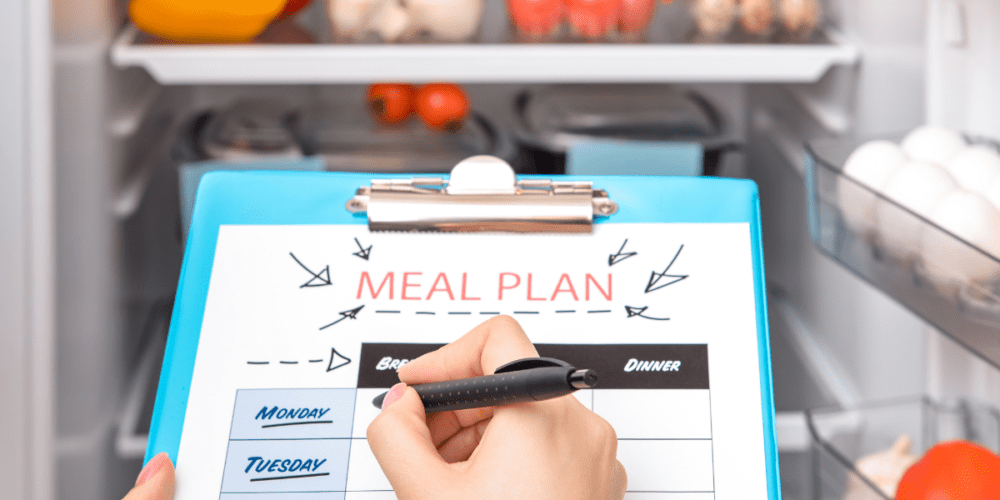In this post, I’m going to share the exact method I use to meal plan each week for my family. It’s practical, easy to follow, and tailored to busy moms and families who want to simplify dinner time and stick to their budget. Come learn some meal planning ideas for families that save time and money! Let’s dive in!

Does dinner time stress you out? I get it—I’ve been there. I used to find myself paralyzed in front of my fridge or kitchen cupboards every evening, wondering what on earth to make. I’d get so frustrated because I had no ideas, no plan, and no thawed meat ready to go. More often than not, I’d end up ordering pizza or hitting the drive-thru just to get through the day.
But let me tell you—it doesn’t have to be this way. Meal planning has been an absolute game-changer for my family and me. Now, instead of dreading dinner time, I know I have a plan. The meat I need is already thawed, and I have a list of meals to choose from. I can just pick the one that sounds best and get cooking. It’s simple, stress-free, and saves me so much time and money!
This post is all about meal planning ideas for families.
How To Meal Plan As A Busy Mom
Step 1: Start With What You Have
Most people start meal planning by picking recipes, but I start in my kitchen!
- Check your fridge, freezer, and pantry to see what you already have.
- Make a quick inventory of the fresh items that need to be used soon, like produce or dairy, as well as proteins and pantry staples.
- This step helps you waste less food and avoid buying things you already own.
Tip: Keep a notepad or digital list handy to jot down your inventory quickly!
Step 2: Check Grocery Store Ads
- Pull up your local grocery store’s weekly ads.
- Look for good deals on items your family uses regularly or that could fill gaps in your pantry.
- Pay special attention to proteins, fresh produce, and pantry staples.
Tip: If your store has loyalty discounts or apps, use them to save even more.
Step 3: Use Your Tried-and-True Recipes
- Pull out a list of meals you know your family loves.
- Check if you already have most of the ingredients for these meals.
- If there’s a recipe you’ve been wanting to try, see if it fits with the ingredients you have or any sales from the ads.
Example: If you have chicken and there’s a sale on broccoli, you can plan for a stir-fry or casserole.
Step 4: Build Your Meal Plan
- Look for meals you can make entirely with what you already have.
- Find meals where you only need to grab one or two additional items.
- Write out a meal plan for the week based on these choices.
Tip: Include at least one flexible meal, like a stir-fry, soup, or pasta dish, to use up odds and ends by the end of the week.
Step 5: Make Your Grocery List
- Write down the minimal groceries you need to complete your meal plan.
- Stick to this list when shopping to stay on budget.
Step 6: Stock Up on Deals
- After grabbing the items for your meal plan, use the rest of your weekly grocery budget to stock up on sale items.
- Focus on things that your family uses regularly, like frozen vegetables, pantry staples, or proteins you can freeze.
Example: If there’s a great deal on ground beef, buy a few extra pounds and freeze it for future meals.
Step 7: Prep for the Week
Once your meal plan is set, take a little time to prep for the week ahead. This step makes dinner time even smoother and saves so much time during busy evenings.
- Thaw Your Meat: If your meal plan includes frozen proteins, pull them out of the freezer and place them in the fridge to thaw. I like to put mine in a casserole dish to catch any juices, just in case there’s a leak.
- Chop Your Veggies: If you know you’ll be using fresh vegetables throughout the week, you can chop them ahead of time and store them in airtight containers. This is especially helpful for stir-fries, soups, or salads.
- Pre-Cook Meat When Possible: For recipes that use ground beef, chicken, or other proteins, consider cooking them ahead of time. For example, if I’m using ground beef in multiple meals, I’ll brown it all at once once it’s thawed. Then, I portion it out for each recipe. On the night I need it, I simply heat it up and season it as needed.
Taking a little time upfront to prep can make dinner time almost effortless during the week!
Why This Process Works
- Saves money: You shop based on what you already have and take advantage of sales.
- Reduces waste: No more forgotten produce or expired pantry items.
- Simplifies dinner: You’re working with recipes you know and love, with room for fun new ideas.
Sample Meal Plan Using This Method
Here’s a peek at my family’s meal plan for this week, created using my simple meal-planning process:
- Broccoli Cheddar Soup: I already had broccoli and cheese on hand, and I just needed some cream.
- Chili and Cornbread: I had ground beef and canned beans in my pantry, so I only needed to grab a few spices and cornmeal.
- Twisted Caesar Salad: Using up leftover chicken and fresh romaine, with a twist by adding homemade croutons and shredded parmesan.
- Honey Glazed Salmon with Rice and Salad: Salmon was on sale this week, and I already had rice and salad greens stocked.
- Pasta with Peppers and Sausage: I had pasta in the pantry, and sausage was part of a great grocery store deal.
- Taco Soup: Using pantry staples like canned tomatoes, beans, and taco seasoning, plus leftover ground beef from the chili.
- Birria Tacos: I had beef in the freezer and tortillas on hand, so I just needed to grab the chilies for the sauce.
- Beef and Broccoli: Leftover beef from the tacos gets repurposed, and broccoli was already in my fridge.
That’s a fantastic tip to include in your blog post! It not only emphasizes your organized approach but also shows how moms can save money by avoiding last-minute trips and full-price purchases. Here’s how we can incorporate it:
Bonus Tip: Keep a Running Pantry and Freezer List
One thing that really helps me stay organized and avoid unnecessary trips to the store is keeping a running list of the items I usually have in my pantry and freezer.
- What’s on the list? I include staples like canned beans, pasta, rice, ground beef, chicken, frozen vegetables, and baking essentials.
- How it helps: If I notice we’re out of something, I make a note of it right away. I also mark it as “out” on my list so I don’t mistakenly plan a meal assuming it’s there.
- Save money: Instead of running to the store and paying full price, I keep an eye out for sales on those items and restock when I find a good deal.
Tip: Hang your list inside a cabinet door or keep it on your phone for easy updates.
Free Printable Meal Planning Checklist
To make meal planning even easier, I’ve created a simple, customizable Meal Planning Checklist for you to use! It included in my overwhelmed mom’s survival kit. It includes sections for:
- Pantry Inventory: Keep track of what you have and what needs to be restocked.
- Freezer Inventory: Note your proteins, frozen vegetables, and any pre-prepped meals.
- Weekly Grocery List: Jot down the few items you need for your meal plan.
- Meal Plan Outline: Organize your dinners for the week, with space for breakfasts, lunches, and snacks if needed.
How to Use It:
- Fill out the inventory sections as you check your fridge, freezer, and pantry.
- Use the checklist to plan your meals based on what you have and the deals you find.
- Print it out or save it digitally so you always have it handy while meal planning or shopping!
Meal planning doesn’t have to be stressful or time-consuming. With this simple process, you can save money, simplify your weeknights, and make the most of what you already have. I hope this helps make your dinner planning a little easier!
This post is all about meal planning ideas for families.





[…] I don’t always follow a strict meal plan, but I do like to keep a flexible approach based on what we have on hand. Most weeks, I pull out a mix of different meats—so we’re not eating all chicken or all pork in one week—and then plan meals around those proteins. […]